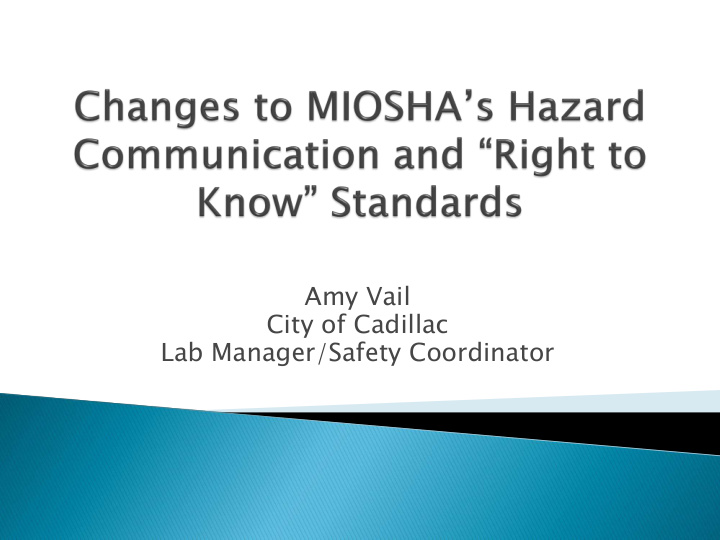



Amy Vail City of Cadillac Lab Manager/Safety Coordinator
Review Updates to HazCom Standard/Labeling and Posting Rules Highlight Changes that Affect Staff Discuss Other MIOSHA Standards Affected Review Available Resources
March 11, 1994 (Current Rule) December 21, 2012 (MIOSHA adoption of OSHA’s revisions) ◦ Part 42 (Construction Safety & Health) ◦ Part 92 (General Industry Safety) ◦ Part 430 (Occupational Health) ◦ Act 154 Section 14 (SDS Modifications) December 1, 2013 (Compliance begins)
Align w/ Globally Harmonized System (GHS) ◦ Common/coherent approach to classify chemicals Improve quality/consistency of hazard ID ◦ Reduce confusion/Increase hazard comprehension ◦ Facilitate training ◦ Address literacy problems Other ◦ Reduce trade barriers ◦ Reduce cost to American businesses
Manufacturers, Distributors, Importers ◦ Change SDS info/format ◦ Change container labeling Employers ◦ SDS ◦ Container labels Employees ◦ Info in new SDS format ◦ Pictograms on container labels ◦ Precautionary/hazard statements
Purpose Definitions Hazard Classification Labels and Other Forms of Warning Safety Data Sheets Employee Information and Training Effective Dates Appendices (A-F)
All hazards are to be classif ified ied ◦ Uses a prescriptive “classification” instead of “performance - oriented” approach Physical Hazard Health Hazard Environmental Hazard
Relocated ◦ Physical hazards now in App. B Deleted ◦ Material safety data sheet Revised/New ◦ Chemical, Hazardous Chemical, Health Hazard, Mixture, Physical Hazard, Label, Pyrophoric ◦ Classification, Hazard Category, Hazard Class, Pictogram, SDS, Substance, Precautionary Statement
Specific and detailed ◦ “Classification” v. “determination” Identify: hazard class under health, physical and environmental Categorize: hazard categories (severity) Inform: place hazard info for each class/category on label and in SDS ◦ Hazard class has detailed criteria ◦ No minimum concentration ◦ Mixture rules specific to each hazard class
Categories ◦ 1-4 (Most severe to least) ◦ Different than other systems ◦ New hazards Simple asphyxiants Pyrophoric gases Combustible dust Hazards not otherwise classified
Material Safety Data Sheets to Safety Data Sheets Ensure employee training on new SDS and label elements conducted
Shipped containers to be labeled with: ◦ Product Identifier ◦ Signal Word ◦ Hazard Statement ◦ Pictograms ◦ Precautionary Statements ◦ Responsible Party
Danger (more severe) Warning (less severe)
Describe hazards associated w/ chemical ◦ Flammable liquid and vapor ◦ Causes skin irritation ◦ May cause cancer
Describe recommend measures related to: ◦ Prevention ◦ Response ◦ Storage ◦ Disposal Examples ◦ Wear respiratory protection ◦ Store in a well ventilated place Not a mandate for employers/employees to follow
Symbol plus other graphic elements intended to convey hazards MIOSHA adopted 8 or 9 All must have red borders All must have pictogram (no blanks)
Skull and Crossbones ◦ Acute Toxicity (fatal or toxic) Exclamation Mark ◦ Irritant, Skin Sensitizer, Acute Toxicity (harmful), Narcotic Effects, Respiratory Irritant Corrosion ◦ Skin Corrosion/Burns, Eye Damage, Corrosive to Metals
Health Hazard ◦ Carcinogen, Mutagenicity, Reproductive Toxicity, Respiratory Sensitizer, Target Organ Toxicity, Aspiration Toxicity Exploding Bomb ◦ Explosives, Self-Reactives, Organic Peroxides Flame ◦ Flammables, Pyrophorics, Self-Heating, Emits Flammable Gas, Self-Reactives, Organic Peroxides
Flame Over Circle ◦ Oxidizers Gas Cylinder ◦ Gases Under Pressure Environment (Non-Mandatory) ◦ Aquatic Toxicity
Still permitted Must be consistent w/ new rule No conflicting hazard warnings/pictograms May use written materials (signs, placards, etc.) in lieu of affixing labels to individual stationary process containers Employer can use GHS compliant labels (same as shipping)
Mandates ◦ 16 Sections MIOSHA will not enforce sections 12-15 (DEQ/EPA will) ◦ Headings ◦ Order of information ◦ What is included under headings
MSDS to SDS
Labels on shipped containers/workplace labels must be explained as well as SDS format Workers will have to be trained on format and content of: ◦ New labels ◦ New SDS
HazCom Training must include: ◦ Signal Words ◦ Pictograms ◦ Hazard classes/categories Physical, health, and not otherwise classified ◦ Labels received on shipped containers ◦ SDS Order/format of info
Hazardous work in labs Flammable liquids/combustibles Process safety management of highly hazardous chemicals (PSM) Hazardous waste and emergency response (HAZWOPER) Methylene Chloride 1,3-Butadiene
Signage Requirements ◦ Cadmium ◦ Lead ◦ Chromium (VI) ◦ Asbestos ◦ Carcinogens ◦ Inorganic Arsenic ◦ Benzene
Effect fective e Comp mplet etion Date Requi uireme ement nt Respo ponsi nsible e Party Train employees on new label Decem ember er 1, 2013 elements and SDS Employer June e 1, 2015 Compliance w/ all modified Chemical manufacturers, provisions of final rule except: importers, distributors, and employers December 1, 2015 The distributor shall not ship Distributor containers labeled by the chemical manufacturer or importer unless it is a GHS label June e 1, 2016 Update alternative workplace Employer labeling and hazcom program as necessary, and provide additional employee training for newly identified hazards
HazCom Web Page www.osha.gov/dsg/hazcom/index.html MIOSHA Web Page http://www.michigan.gov/lara/0,4601,7-154- 61256_11407---,00.html
Amy Vail City of Cadillac (231)775-2368 lab@cadillac-mi.net
Recommend
More recommend